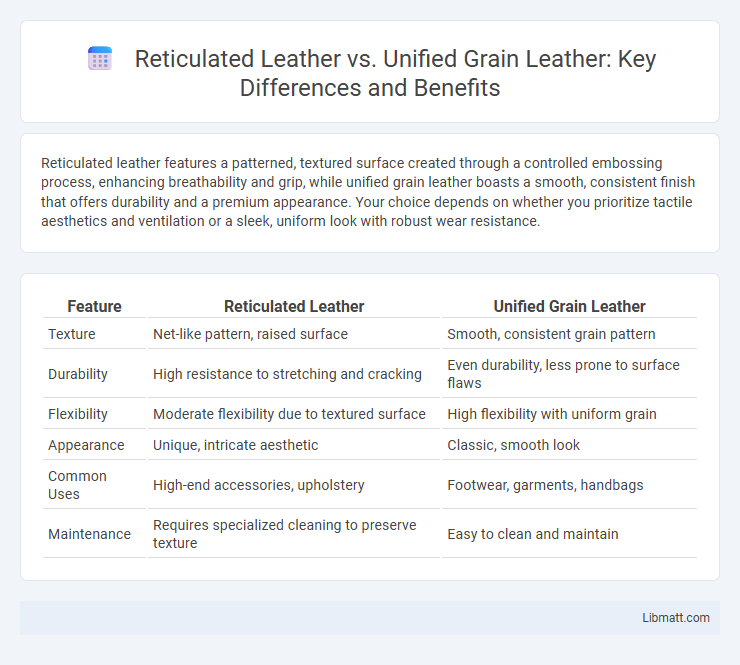Reticulated leather features a patterned, textured surface created through a controlled embossing process, enhancing breathability and grip, while unified grain leather boasts a smooth, consistent finish that offers durability and a premium appearance. Your choice depends on whether you prioritize tactile aesthetics and ventilation or a sleek, uniform look with robust wear resistance.
Table of Comparison
| Feature | Reticulated Leather | Unified Grain Leather |
|---|---|---|
| Texture | Net-like pattern, raised surface | Smooth, consistent grain pattern |
| Durability | High resistance to stretching and cracking | Even durability, less prone to surface flaws |
| Flexibility | Moderate flexibility due to textured surface | High flexibility with uniform grain |
| Appearance | Unique, intricate aesthetic | Classic, smooth look |
| Common Uses | High-end accessories, upholstery | Footwear, garments, handbags |
| Maintenance | Requires specialized cleaning to preserve texture | Easy to clean and maintain |
Introduction to Leather Types
Reticulated leather features a distinct, textured pattern created by a controlled embossing process, offering enhanced grip and a unique visual appeal. Unified grain leather, on the other hand, is crafted from a single continuous layer of natural hide, providing smoothness, durability, and a consistent surface ideal for high-quality upholstery and fashion items. Understanding these leather types helps you choose materials based on texture preference, durability needs, and aesthetic requirements.
What is Reticulated Leather?
Reticulated leather features a distinct pattern created by embossing or laser etching, giving it a textured, web-like surface that enhances breathability and grip. Unlike unified grain leather, which has a smooth, consistent finish, reticulated leather emphasizes both aesthetic appeal and functional performance in products like luxury car interiors and high-end footwear. Your choice depends on whether you prioritize texture and ventilation or uniformity and classic elegance.
Understanding Unified Grain Leather
Unified grain leather is crafted from a single, smooth layer of the animal hide, offering a consistent texture and enhanced durability compared to reticulated leather, which features a textured, net-like pattern. This type of leather retains the natural grain, providing a more refined appearance and better resistance to wear and tear, making it ideal for high-quality furniture and automotive interiors. Understanding unified grain leather helps you appreciate its superior strength and smooth finish, essential for products demanding both elegance and longevity.
Key Differences Between Reticulated and Unified Grain Leather
Reticulated leather features a distinctive network-like pattern achieved through a specialized embossing process, enhancing breathability and aesthetic appeal, while unified grain leather boasts a smooth, consistent surface without visible pores, providing durability and a refined look. The key differences lie in texture and finishing; reticulated leather often allows more flexibility and airflow due to its porous design, whereas unified grain leather emphasizes uniformity and resistance to wear. These characteristics influence their typical applications, with reticulated leather favored for casual, breathable items and unified grain leather preferred for formal, long-lasting products.
Appearance and Texture Comparison
Reticulated leather features a distinct, patterned surface with a network of raised ridges and valleys, offering a textured, visually dynamic appearance that enhances grip and durability. Unified grain leather, by contrast, displays a smooth, consistent surface with uniform grain patterns that provide a sleek, polished look and a soft, supple feel. Your choice depends on whether you prefer the rugged, tactile quality of reticulated leather or the refined elegance and smooth texture of unified grain leather.
Durability and Strength Analysis
Reticulated leather features a unique, web-like texture created through a specialized embossing process, offering enhanced flexibility but slightly less tensile strength compared to unified grain leather, which is made from a continuous, undisturbed hide with superior durability. Unified grain leather's consistent fiber structure makes it more resistant to wear, stretching, and aging, ideal for products requiring long-term resilience such as high-end furniture or automotive seating. Understanding these differences ensures Your choice aligns with the durability demands of your leather goods, balancing toughness with aesthetic appeal.
Common Uses in Fashion and Upholstery
Reticulated leather, known for its intricate, web-like pattern, is commonly used in fashion for statement pieces such as jackets, handbags, and footwear that require a unique, textured appearance. Unified grain leather, valued for its smooth, consistent surface, dominates upholstery applications in luxury furniture and car interiors where durability and a refined aesthetic are essential. Your choice between these leathers depends on whether you prioritize visually striking designs or classic, elegant finishes for fashion or upholstery projects.
Maintenance and Care Tips
Reticulated leather requires regular cleaning with a soft brush to remove dirt trapped in its textured surface, followed by conditioning with a specialized leather conditioner to maintain its flexibility. Unified grain leather benefits from frequent wiping with a damp cloth and application of a high-quality leather cream to preserve its smooth, uniform appearance while preventing cracking. Avoid exposing both types to direct sunlight and moisture to extend their lifespan and maintain their aesthetic qualities.
Price and Value Considerations
Reticulated leather typically commands a higher price due to its intricate pattern and labor-intensive production process, making it a premium choice for luxury goods. Unified grain leather offers a more affordable alternative with consistent texture and durability, providing good value for everyday use. When selecting leather for your purchase, consider if the unique aesthetic of reticulated leather justifies the extra cost compared to the practical benefits of unified grain leather.
Which Leather is Best for Your Needs?
Reticulated leather features a distinctive textured pattern that enhances breathability and grip, making it ideal for items requiring durability and aesthetic appeal. Unified grain leather, with its smooth, uniform surface, offers superior strength and a sleek appearance suitable for luxury goods and long-lasting furniture. Your choice depends on whether you prioritize the rugged functionality of reticulated leather or the refined elegance and durability of unified grain leather.
Reticulated leather vs unified grain leather Infographic

 libmatt.com
libmatt.com